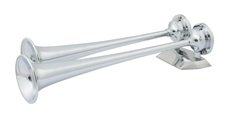Regarding Colregs (Rules of the road) compliance with annex III.
I think it important to have the proper whistle (horn) installed for required use as defined by PART D SOUND AND LIGHT SIGNALS. Your whistle is a device that conveys information about your size. I don't want a deep draft ship or big tow trying to find another big one when I need them to pay attention to me.
That said in my opinion I think it's OK to have an additional non compliant whistle like a train horn for fun. Just be sure to not use the fun horn when it might confuse things.
Kahlenberg makes it easy to hear the proper frequencies. Pick a horn that matches your boat length and listen.
—INTERNATIONAL—
ANNEX III -
Technical Details of Sound Signal Appliances
1. Whistles
(a) Frequencies and range of audibility
The fundamental frequency of the signal shall lie within the range 70-700
Hz. The range of audibility of the signal from a whistle shall be determined
by those frequencies, which may include the fundamental and/or one or
more higher frequencies, which lie within the range 180-700 Hz (+/- 1%) for
a vessel of 20 meters or more in length, or 180-2100Hz (+/- 1%) for a vessel
of less than 20 meters in length and which provide the sound pressure
levels specified in paragraph 1(c) below.
(b) Limits of fundamental frequencies
To ensure a wide variety of whistle characteristics, the fundamental
frequency of a whistle shall be between the following limits:
(i) 70-200 Hz, for a vessel 200 meters or more in length;
(ii) 130-350 Hz, for a vessel 75 meters but less than 200 meters in
length;
(iii) 250-700 Hz, for a vessel less than 75 meters in length.


